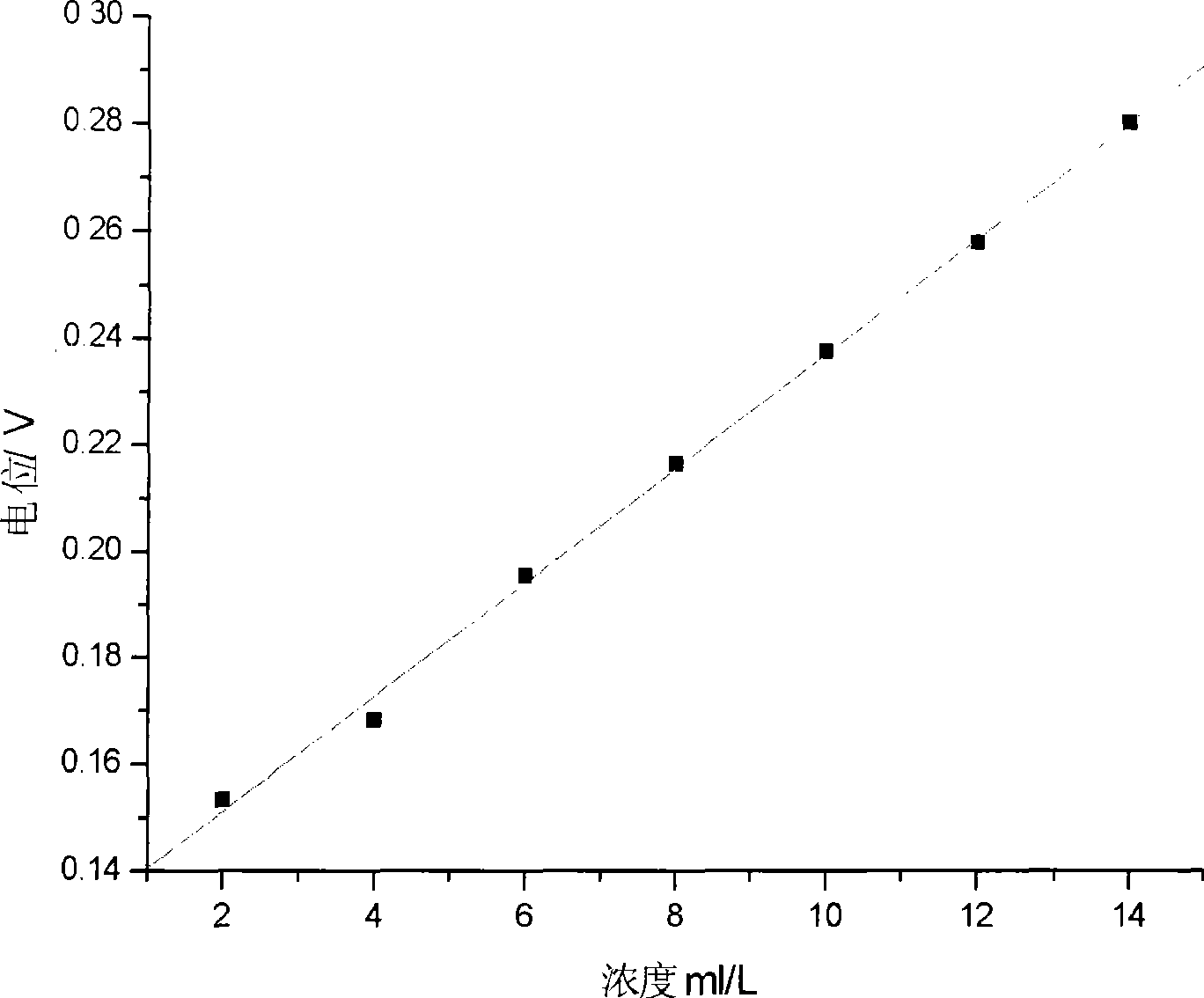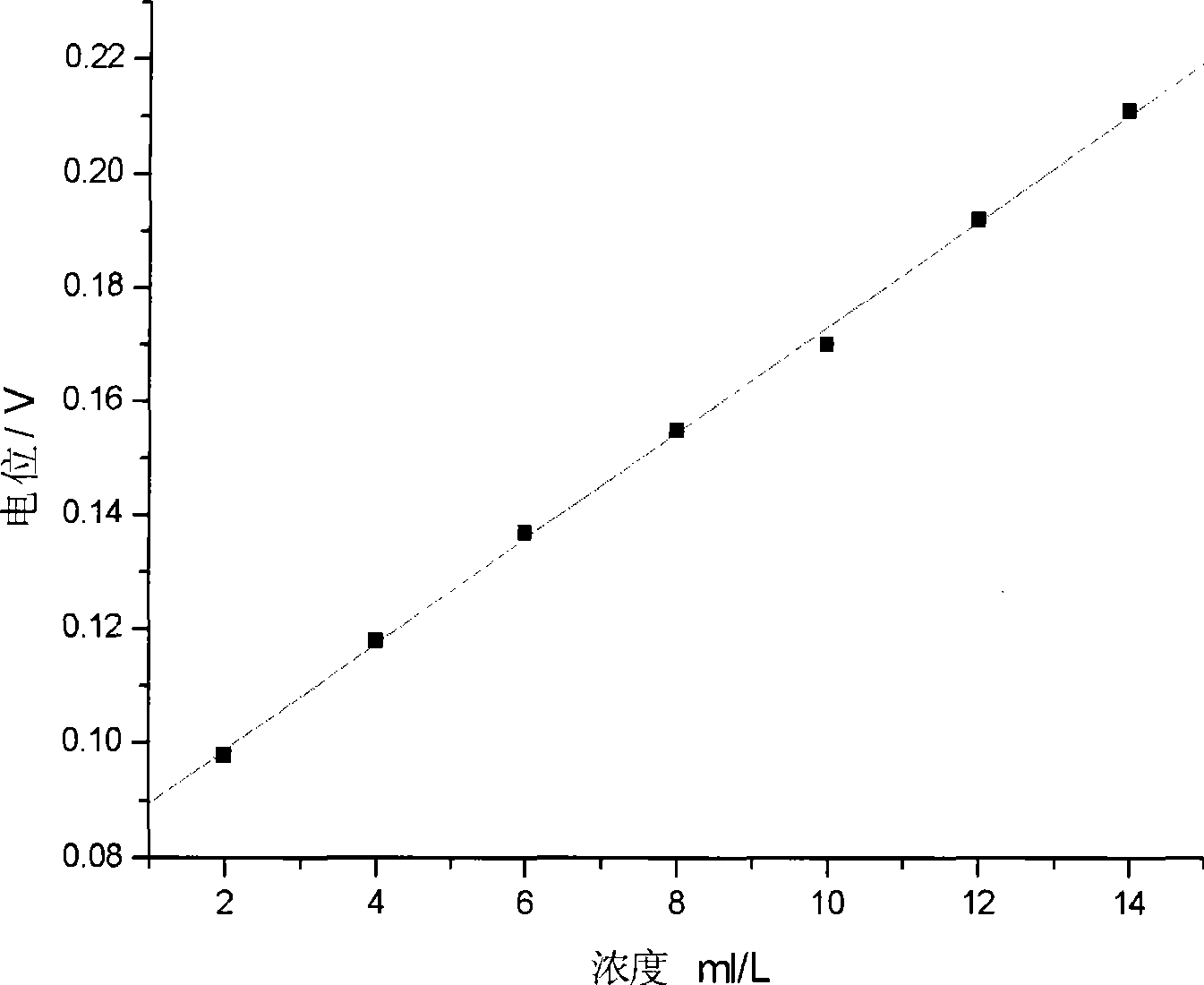Measuring method for concentration of organic additive in plating solution
A technology of organic additives and measurement methods, applied in the direction of material electrochemical variables, etc., can solve the problems of complex process and time-consuming, and achieve the effect of small measurement deviation, low instrument accuracy and experimental operation requirements
- Summary
- Abstract
- Description
- Claims
- Application Information
AI Technical Summary
Problems solved by technology
Method used
Image
Examples
Embodiment 1
[0033] This embodiment illustrates the method for measuring the concentration of organic additives in the electroplating solution of the present invention.
[0034] (1) The electroplating solution to be tested is an aqueous solution, which contains 6.00ml / L inhibitor (19280 produced by Mai Demei), 70g / L CuSO 4 ·5H 2 O, 100g / L of H 2 SO 4 , 50ppm hydrochloric acid.
[0035] (2) Blank plating solution A is an aqueous solution containing 70g / L of CuSO 4 ·5H 2 O, 100g / L of H 2 SO 4 , 50ppm hydrochloric acid.
[0036] (3) In addition to the inhibitors containing 2ml / L, 4ml / L, 6ml / L, 8ml / L, 10ml / L, 12ml / L, and 14ml / L respectively, the other components and concentrations of the seven standard plating solutions A Both have the same composition as the blank plating solution A.
[0037] 2) Preparation method of porous mesh platinum electrode
[0038] Dip the titanium sheet in 1mol / L hydrochloric acid, react at 85°C for 10min, and clean the surface. Clean in water for 10min un...
Embodiment 2
[0045] This embodiment illustrates the method for measuring the concentration of organic additives in the electroplating solution of the present invention.
[0046] (1) The electroplating solution to be tested is an aqueous solution, which contains 2.50ml / L brightener (19241 produced by Maidemi), 70g / L CuSO 4 ·5H 2 O, 100g / L of H 2 SO 4 , 50ppm hydrochloric acid.
[0047] (2) Blank plating solution A is an aqueous solution containing 70g / L of CuSO 4 ·5H 2 O, 100g / L of H 2 SO 4 , 50ppm hydrochloric acid.
[0048] (3) In addition to the brighteners containing 0.6ml / L, 1.2ml / L, 1.8ml / L, 2.4ml / L, 3.0ml / L, and 3.6ml / L respectively, other components of the six standard plating solutions B And its concentration is the same as the composition of blank plating solution A.
[0049] 2) Preparation method of porous mesh platinum electrode
[0050] Dip the titanium sheet in 1mol / L hydrochloric acid, react at 85°C for 10min, and clean the surface. Clean in water for 10min under u...
Embodiment 3
[0057] This embodiment illustrates the method for measuring the concentration of organic additives in the electroplating solution of the present invention.
[0058] 1) Reagents:
[0059] (1) The electroplating solution to be tested is an aqueous solution, which contains 6.00ml / L of inhibitor (19280 produced by Maidemi), 2.50ml / L of brightener (19241 produced by Maidemi), and 70g / L of CuSO 4 ·5H 2 O, 100g / L of H 2 SO 4 , 50ppm hydrochloric acid.
[0060] (2) Blank plating solution A is an aqueous solution containing 70g / L of CuSO 4 ·5H 2 O, 100g / L of H 2 SO 4 , 50ppm hydrochloric acid.
[0061](3) In addition to the inhibitors containing 2ml / L, 4ml / L, 6ml / L, 8ml / L, 10ml / L, 12ml / L, and 14ml / L respectively, the other components and concentrations of the seven standard plating solutions A Both have the same composition as the blank plating solution A.
[0062] (4) Blank plating solution B is an aqueous solution containing 35ml / L of inhibitors and 70g / L of CuSO 4 ·5H 2 ...
PUM
| Property | Measurement | Unit |
|---|---|---|
| current density | aaaaa | aaaaa |
| current density | aaaaa | aaaaa |
Abstract
Description
Claims
Application Information
 Login to View More
Login to View More - R&D
- Intellectual Property
- Life Sciences
- Materials
- Tech Scout
- Unparalleled Data Quality
- Higher Quality Content
- 60% Fewer Hallucinations
Browse by: Latest US Patents, China's latest patents, Technical Efficacy Thesaurus, Application Domain, Technology Topic, Popular Technical Reports.
© 2025 PatSnap. All rights reserved.Legal|Privacy policy|Modern Slavery Act Transparency Statement|Sitemap|About US| Contact US: help@patsnap.com



